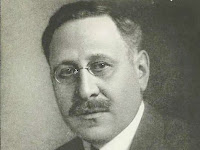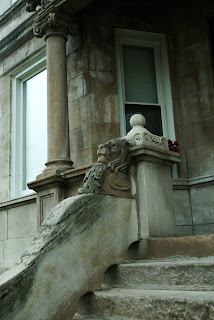
Homan Square is an area in North Lawndale, generally centered at the intersection of South Homan Avenue and Arthington Street. Many will recognize this as the area that held the corporate office and major operations for Sears Roebuck and Company. Sears and the other industrial titans that settled in and around Lawndale drove the residential population explosion that occurred around the beginning of the twentieth century. Of course Sears in Lawndale offers many narratives.
The Local Narrative

Perhaps the most compelling local narrative for Lawndale and Chicago over the last couple of decades is Sears’ decision to leave North Lawndale and build its iconic tower on Wacker Drive in Chicago’s Loop. The initial move by Sears involved its corporate offices. Ultimately, all its operations were moved out of Lawndale. In the wake of this move vast amounts of unused industrial buildings were left in the middle of the community. Charlie Shaw of the Shaw Company acquired much of the old Sears complex, including the corporate headquarters building at 3333 West Arthington Street. The Shaw Company developed residential housing in the area, the first new housing that had been built in the neighborhood in decades. This effort garnered much attention locally and nationally. Ellis Cose wrote the following in a Newsweek article in 1999:
"Nonetheless, for a community yet haunted by the memory of Jim Crow, this is a remarkable moment. One of the most dramatic signs of progress is the explosion of productive activity as once desolate inner-city neighborhoods, such as Chicago's North Lawndale, come to life. In 1966, this area on Chicago's West Side was so blighted that Martin Luther King rented an apartment there to call attention to it. Then things got worse. The area was largely incinerated by the riots that broke out in the wake of King's assassination in 1968. More than half of the population moved out between 1960 and 1990. Now new construction is shooting up. Homes are selling for as much as $275,000 apiece. And the young black professionals flocking back to buy them talk of renaissance and hope reborn.
"People wrote this area off. They didn't believe middle-class African-Americans would come back here. Now we're making this neighborhood work," says Demetrius Barbee. For Barbee, a Blockbuster executive, and her husband, Gerald, a medical-equipment technician, trading in a fancy North Lake Shore Drive address for a North Lawndale dream house was not merely a matter of getting good quality for a good price. It was an investment of hope in the very idea of a community coming back from the dead.
Homan Square, the development where the Barbees now live, resulted from a serendipitous confluence of events. Sears, having moved its onetime world headquarters out of the area, had plenty of well-maintained land it was willing to donate to the project. Mayor Richard M. Daley was eager to facilitate--providing, among other assistance, grants to first-time homeowners. And an important developer, the Shaw Co., saw the value of the enterprise. The Homan Square experiment in urban reclamation has covered six city blocks with 299 units of housing, 133 of them owner-occupied single-family homes. It has also spawned a health clinic, several new businesses and numerous other construction projects. Perhaps most important, it has inspired other developers. Just southeast of Homan Square sits a new shopping center anchored by a Dominick's supermarket and a 10-screen Cineplex Odeon Theater. A few blocks away, another town-house development has gone up. Central City Productions, a local black-owned entertainment company, plans to build a $150 million, 337,000-square-foot television-studio complex. And other projects are pending."
Since the late 1990's a campus of sorts has developed at Homan Square. In addition to the residential component, the Homan Square Community Center, a new YMCA, and two schools have been added.
The Homan Square Community Center provides a variety of services for the community. It houses the offices of the Homan Square Community Center Foundation, a branch of the Lawndale Christian Health Center, and provides facilities for the Chicago Park District.
Two school have been developed on the campus as well as a new facility for the YMCA.
 |
| Family Lutheran Center School |
 |
| Family Lutheran Center School |
 |
| North Lawndale Y |
Power House High School is an award winning example of reusing buildings thought to be obsolete. The Power House generated power for the massive Sears complex, beginning in 1905. Additional information about the history of the building as well as some great period photographs can be found at the following link.
http://education.homansquare.org/content/index.php?cat=3
 |
| Add caption |
 |
| Kristin Dean and her father |
The largest structure from the Sears campus has been demolished, however, several extremely impressive building remain, including the original administration building, and the power house, now as Power House High School. The administration building is still used as office space by a variety of entities. It serves as the District Office for Congressman Danny Davis of Illinois' 7th Congressional District. The other buildings include the old Allstate building as well as the product development building, both of which are not currently used.
 |
| Administration Building |
 |
| Allstate |
 |
| Merchandise Development and Printing |
The National Narrative
 The Sears in Lawndale narrative that is of some national significance speaks to the nature of Lawndale as a place where Jewish and African-American interests come together. Julius Rosenwald, an early CEO of Sears, was a major philanthropist, donating much of his fortune to African-American causes. Rosenwald was Jewish. From his Lawndale office he supported the building of schools for African-Americans in the South. The National Trust for Historic Preservation described the effort in the following manner.
The Sears in Lawndale narrative that is of some national significance speaks to the nature of Lawndale as a place where Jewish and African-American interests come together. Julius Rosenwald, an early CEO of Sears, was a major philanthropist, donating much of his fortune to African-American causes. Rosenwald was Jewish. From his Lawndale office he supported the building of schools for African-Americans in the South. The National Trust for Historic Preservation described the effort in the following manner.
"The Rosenwald rural school building program was a major effort to improve the quality of public education for African Americans in the early twentieth-century South. In 1912, Julius Rosenwald gave Booker T. Washington permission to use some of the money he had donated to Tuskegee Institute for the construction of six small schools in rural Alabama, which were constructed and opened in 1913 and 1914. Pleased with the results, Rosenwald then agreed to fund a larger program for schoolhouse construction based at Tuskegee. In 1917 he set up the Julius Rosenwald Fund, a Chicago-based philanthropic foundation, and in 1920 the Rosenwald Fund established an independent office for the school building program in Nashville, Tennessee. By 1928, one in every five rural schools for black students in the South was a Rosenwald school, and these schools housed one third of the region's rural black schoolchildren and teachers. At the program's conclusion in 1932, it had produced 4,977 new schools, 217 teachers' homes, and 163 shop buildings, constructed at a total cost of $28,408,520 to serve 663,615 students in 883 counties of 15 states." http://www.preservationnation.org/travel-and-sites/sites/southern-region/rosenwald-schools/history/
 |
| Aaron Douglas' Harriet Tubman |
Rosenwald also contributed generously to African-American artists. Spertus Museum, at Chicago's Spertus Institute of Jewish Studies, presented A Force for Change: African American Art and the Julius Rosenwald Fund, in 2009. This was the first exhibition to explore the legacy of Julius Rosenwald’s philanthropy in this arena.
 |
| Elizabeth Catlett |
 |
| Robert Gwathmey, Portrait of a Farmer's Wife |
 |
| Augusta Savage, Gamin |
The Julius Rosenwald Fund was created in 1917. From 1928 to 1948, the Rosenwald Fund's Fellowship Program awarded stipends to hundreds of African American artists, writers, teachers, and scholars -- many with ties to Chicago -- as well as white southerners with an interest in race relations. Among the impressive list of Rosenwald Fellows were some of the leading artists of the decades between the two world wars, and the work they produced with Rosenwald support was made under conditions of exceptional artistic security and freedom. The work of these artists, such as Elizabeth Catlett, Eldzier Cortor, Aaron Douglas, Jacob Lawrence, Gordon Parks, Marion Perkins, Rose Piper, Augusta Savage, and Charles White, was the focus of A Force for Change.
Source: A Force for Change: African-American Art and the Julius Rosenwald Fund. Spertus Museum.
 The Sears in Lawndale narrative that is of some national significance speaks to the nature of Lawndale as a place where Jewish and African-American interests come together. Julius Rosenwald, an early CEO of Sears, was a major philanthropist, donating much of his fortune to African-American causes. Rosenwald was Jewish. From his Lawndale office he supported the building of schools for African-Americans in the South. The National Trust for Historic Preservation described the effort in the following manner.
The Sears in Lawndale narrative that is of some national significance speaks to the nature of Lawndale as a place where Jewish and African-American interests come together. Julius Rosenwald, an early CEO of Sears, was a major philanthropist, donating much of his fortune to African-American causes. Rosenwald was Jewish. From his Lawndale office he supported the building of schools for African-Americans in the South. The National Trust for Historic Preservation described the effort in the following manner. The Sears in Lawndale narrative that is of some national significance speaks to the nature of Lawndale as a place where Jewish and African-American interests come together. Julius Rosenwald, an early CEO of Sears, was a major philanthropist, donating much of his fortune to African-American causes. Rosenwald was Jewish. From his Lawndale office he supported the building of schools for African-Americans in the South. The National Trust for Historic Preservation described the effort in the following manner.
The Sears in Lawndale narrative that is of some national significance speaks to the nature of Lawndale as a place where Jewish and African-American interests come together. Julius Rosenwald, an early CEO of Sears, was a major philanthropist, donating much of his fortune to African-American causes. Rosenwald was Jewish. From his Lawndale office he supported the building of schools for African-Americans in the South. The National Trust for Historic Preservation described the effort in the following manner.



 Early in 2006 Roberta Feldman of the University of Illinois at Chicago’s City Design Center and I were having a conversation about communication strategies for utilizing history and culture as a tool to help community residents become more invested and engaged in the community. I had come to recognize how complex and compelling the Lawndale story is, and thought that this story had to be told. Perhaps there are many ways to accomplish such an objective, but the consensus was that there had to be “a book.” …And, that it shouldn’t be any book, but one that would begin to outline the historical narrative in a compelling way. There had to be great images of the community’s built environment.
Early in 2006 Roberta Feldman of the University of Illinois at Chicago’s City Design Center and I were having a conversation about communication strategies for utilizing history and culture as a tool to help community residents become more invested and engaged in the community. I had come to recognize how complex and compelling the Lawndale story is, and thought that this story had to be told. Perhaps there are many ways to accomplish such an objective, but the consensus was that there had to be “a book.” …And, that it shouldn’t be any book, but one that would begin to outline the historical narrative in a compelling way. There had to be great images of the community’s built environment. 









